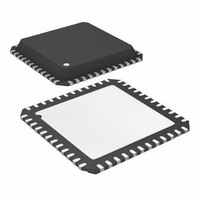ATA6613P-PLQW Atmel, ATA6613P-PLQW Datasheet - Page 108

ATA6613P-PLQW
Manufacturer Part Number
ATA6613P-PLQW
Description
MCU W/LIN TXRX REG WTCHDG 48-QFN
Manufacturer
Atmel
Series
AVR® ATA66 LIN-SBCr
Datasheet
1.ATA6612-EK.pdf
(364 pages)
Specifications of ATA6613P-PLQW
Core Processor
AVR
Core Size
8-Bit
Speed
16MHz
Connectivity
I²C, LIN, SPI, UART/USART
Peripherals
Brown-out Detect/Reset, POR, PWM, WDT
Number Of I /o
23
Program Memory Size
16KB (16K x 8)
Program Memory Type
FLASH
Eeprom Size
512 x 8
Ram Size
1K x 8
Voltage - Supply (vcc/vdd)
2.7 V ~ 5.5 V
Data Converters
A/D 8x10b
Oscillator Type
Internal
Operating Temperature
-40°C ~ 125°C
Package / Case
48-QFN Exposed Pad
Processor Series
ATA6x
Core
AVR8
Data Bus Width
8 bit
Data Ram Size
1 KB
Interface Type
I2C, SPI, USART
Maximum Clock Frequency
16 MHz
Number Of Programmable I/os
23
Number Of Timers
3
Maximum Operating Temperature
+ 125 C
Mounting Style
SMD/SMT
Minimum Operating Temperature
- 40 C
On-chip Adc
10 bit, 8 Channel
Lead Free Status / RoHS Status
Lead free / RoHS Compliant
Available stocks
Company
Part Number
Manufacturer
Quantity
Price
Company:
Part Number:
ATA6613P-PLQW
Manufacturer:
ATMEL
Quantity:
5 000
Part Number:
ATA6613P-PLQW
Manufacturer:
ATMEL/爱特梅尔
Quantity:
20 000
- Current page: 108 of 364
- Download datasheet (7Mb)
6.10.4.8
6.10.4.9
6.11
108
External Interrupts
Atmel ATA6612/ATA6613
The Port D Data Direction Register – DDRD
The Port D Input Pins Address – PIND
The External Interrupts are triggered by the INT0 and INT1 pins or any of the PCINT23..0 pins.
Observe that, if enabled, the interrupts will trigger even if the INT0 and INT1 or PCINT23..0
pins are configured as outputs. This feature provides a way of generating a software interrupt.
The pin change interrupt PCI2 will trigger if any enabled PCINT23..16 pin toggles. The pin
change interrupt PCI1 will trigger if any enabled PCINT14..8 pin toggles. The pin change inter-
rupt PCI0 will trigger if any enabled PCINT7..0 pin toggles. The PCMSK2, PCMSK1 and
PCMSK0 Registers control which pins contribute to the pin change interrupts. Pin change
interrupts on PCINT23..0 are detected asynchronously. This implies that these interrupts can
be used for waking the part also from sleep modes other than Idle mode.
The INT0 and INT1 interrupts can be triggered by a falling or rising edge or a low level. This is
set up as indicated in the specification for the External Interrupt Control Register A – EICRA.
When the INT0 or INT1 interrupts are enabled and are configured as level triggered, the inter-
rupts will trigger as long as the pin is held low. Note that recognition of falling or rising edge
interrupts on INT0 or INT1 requires the presence of an I/O clock, described in
and their Distribution” on page
nously. This implies that this interrupt can be used for waking the part also from sleep modes
other than Idle mode. The I/O clock is halted in all sleep modes except Idle mode.
Note that if a level triggered interrupt is used for wake-up from Power-down, the required level
must be held long enough for the MCU to complete the wake-up to trigger the level interrupt. If
the level disappears before the end of the Start-up Time, the MCU will still wake up, but no
interrupt will be generated. The start-up time is defined by the SUT and CKSEL Fuses as
described in
Read/Write
Initial Value
Read/Write
Initial Value
Bit
Bit
“System Clock and Clock Options” on page
PIND7
DDD7
R/W
N/A
R
7
0
7
PIND6
DDD6
R/W
N/A
R
6
0
6
51. Low level interrupt on INT0 and INT1 is detected asynchro-
PIND5
DDD5
R/W
N/A
R
5
0
5
PIND4
DDD4
R/W
N/A
R
4
0
4
PIND3
DDD3
R/W
N/A
R
3
0
3
51.
PIND2
DDD2
R/W
N/A
R
2
0
2
PIND1
DDD1
R/W
N/A
R
1
0
1
PIND0
DDD0
“Clock Systems
R/W
N/A
9111H–AUTO–01/11
R
0
0
0
DDRD
PIND
Related parts for ATA6613P-PLQW
Image
Part Number
Description
Manufacturer
Datasheet
Request
R

Part Number:
Description:
MCU W/LIN TXRX REG WTCHDG 48-QFN
Manufacturer:
Atmel
Datasheet:

Part Number:
Description:
Ata6613
Manufacturer:
ATMEL Corporation
Datasheet:

Part Number:
Description:
BOARD DEMO LIN-MCM FOR ATA6613
Manufacturer:
Atmel
Datasheet:

Part Number:
Description:
DEV KIT FOR AVR/AVR32
Manufacturer:
Atmel
Datasheet:

Part Number:
Description:
INTERVAL AND WIPE/WASH WIPER CONTROL IC WITH DELAY
Manufacturer:
ATMEL Corporation
Datasheet:

Part Number:
Description:
Low-Voltage Voice-Switched IC for Hands-Free Operation
Manufacturer:
ATMEL Corporation
Datasheet:

Part Number:
Description:
MONOLITHIC INTEGRATED FEATUREPHONE CIRCUIT
Manufacturer:
ATMEL Corporation
Datasheet:

Part Number:
Description:
AM-FM Receiver IC U4255BM-M
Manufacturer:
ATMEL Corporation
Datasheet:

Part Number:
Description:
Monolithic Integrated Feature Phone Circuit
Manufacturer:
ATMEL Corporation
Datasheet:

Part Number:
Description:
Multistandard Video-IF and Quasi Parallel Sound Processing
Manufacturer:
ATMEL Corporation
Datasheet:

Part Number:
Description:
High-performance EE PLD
Manufacturer:
ATMEL Corporation
Datasheet:

Part Number:
Description:
8-bit Flash Microcontroller
Manufacturer:
ATMEL Corporation
Datasheet:











